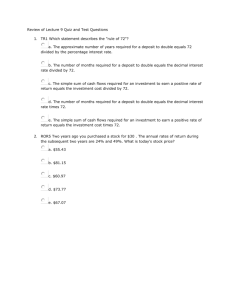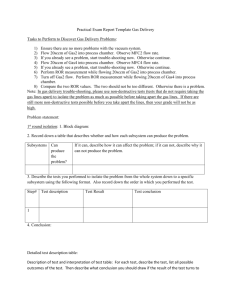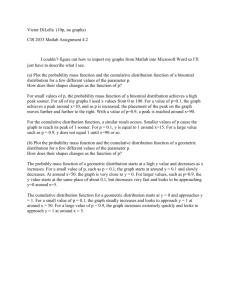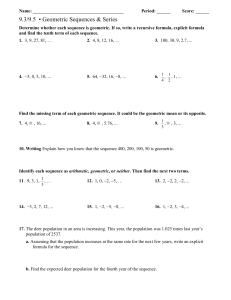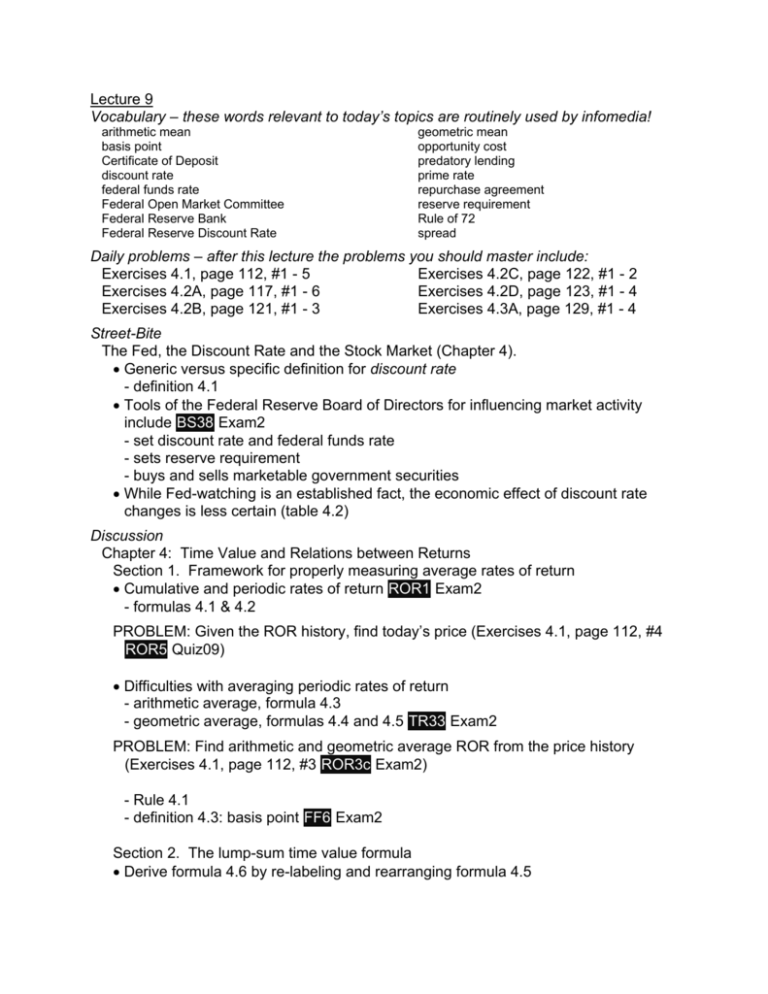
Lecture 9
Vocabulary – these words relevant to today’s topics are routinely used by infomedia!
arithmetic mean
basis point
Certificate of Deposit
discount rate
federal funds rate
Federal Open Market Committee
Federal Reserve Bank
Federal Reserve Discount Rate
geometric mean
opportunity cost
predatory lending
prime rate
repurchase agreement
reserve requirement
Rule of 72
spread
Daily problems – after this lecture the problems you should master include:
Exercises 4.1, page 112, #1 - 5
Exercises 4.2C, page 122, #1 - 2
Exercises 4.2A, page 117, #1 - 6
Exercises 4.2D, page 123, #1 - 4
Exercises 4.2B, page 121, #1 - 3
Exercises 4.3A, page 129, #1 - 4
Street-Bite
The Fed, the Discount Rate and the Stock Market (Chapter 4).
Generic versus specific definition for discount rate
- definition 4.1
Tools of the Federal Reserve Board of Directors for influencing market activity
include BS38 Exam2
- set discount rate and federal funds rate
- sets reserve requirement
- buys and sells marketable government securities
While Fed-watching is an established fact, the economic effect of discount rate
changes is less certain (table 4.2)
Discussion
Chapter 4: Time Value and Relations between Returns
Section 1. Framework for properly measuring average rates of return
Cumulative and periodic rates of return ROR1 Exam2
- formulas 4.1 & 4.2
PROBLEM: Given the ROR history, find today’s price (Exercises 4.1, page 112, #4
ROR5 Quiz09)
Difficulties with averaging periodic rates of return
- arithmetic average, formula 4.3
- geometric average, formulas 4.4 and 4.5 TR33 Exam2
PROBLEM: Find arithmetic and geometric average ROR from the price history
(Exercises 4.1, page 112, #3 ROR3c Exam2)
- Rule 4.1
- definition 4.3: basis point FF6 Exam2
Section 2. The lump-sum time value formula
Derive formula 4.6 by re-labeling and rearranging formula 4.5
Components of time value accretion
- periodic interest, formula 4.7 LS6a Exam2
- interest versus principal, formula 4.8
- interest-on-interest versus interest-on-principal, formula 4.9
PROBLEM: Find interest-on-interest and interest-on-principal (Exercises 4.2A, page
117, #4 LS4c,d Exam2
- Rule of 72 (Rule 4.1) TR1 Exam2 Quiz09
Section 3. Intraperiod compounding
Explanation of Table 4.3
- role of interest-on-interest TR2 Exam2
- annual percentage rate versus periodic rate
PROBLEM: Find initial price of savings bond (Exercises 4.3A, page 129, #2 CY7
nxq.
FOLLOW-UP: Partition total interest into interest-on-interest and interest-onprincipal
Quiz 9 TR1 (30% Exam2 DG#9), ROR5 (30% DG#9), LS10a (40% Exam2 WG#4)
Videos for Lecture 9 (TOTAL: 15@82’28”)
o Streetbite on the discount rate and the Fed (10:50)
o The cumulative rate of return (3:14) [ROR1 modified]
o The periodic rate of return and the arithmatic average ROR (6:23)
o The geometric average ROR (4:15)
o What is a basis point? (1:55)
o The difference between the geometric and arithmatic average ROR (6:10)
o Derivation of the lump-sum time value relation (6:59) [LS4a]
o The Rule of 72 finds the length of a doubling period (2:49)
o Using the calculator time value keys to find FV and periodic interest (7:46) [LS6a]
o Find balance after crediting of periodic interest (3:07) [LS7a]
o Find shortfall given target FV, target r, and actual r (4:47) [LS10a]
o Periodic components of time value: interest-on-interest and interest-on-principal
(7:38) [LS4c,d]
o Intraperiod compounding of interest within a year (7:11)
o Use intraperiod compounding to find FV (3:47) [CY7]
o Find actual APR given lump-sum surplus (5:46) [CY10a]
o
o
Lessons about the Structure of Finance. © 2014 by Thomas W. Downs. All rights reserved. http://bama.ua.edu/~fi302/Lecture_09.pdf
DEFINITION 4.1 Discount rate
The discount rate is the periodic percentage return subtracted from the future cash flow
for computing present value.
The Federal Reserve Board of Directors, led by its presidentially appointed
congressionally approved powerful Chair, uses 3 main tools to influence market activity.
These include:
1• the Federal Reserve Board votes whether to raise or lower the official government discount rate; this
is the interest rate charged by federal district banks to member public and private banks.
Lessons about the Structure of Finance. © 2014 by Thomas W. Downs. All rights reserved. http://bama.ua.edu/~fi302/Lecture_09.pdf
• the Fed sets the reserve requirement on member bank accounts; this regulates the amount of loans
that banks may lend to business and individual borrowers.
• the Fed buys and sells marketable currencies and government securities in the global financial
marketplace; this affects supply and demand conditions.
BS38 Describe the three tools of the Fed
The Federal Reserve Board of Directors uses three significant tools to influence market
activity. Which of these statements is the most accurate description of Fed tools?
a. The official government “federal funds rate” is the interest rate charged by Federal
Reserve District banks to member public and private banks.
b. The reserve requirement on member bank accounts regulates the amount of
loans that banks may lend to business and individual borrowers.
c. Buying and selling currencies and government securities in the global financial
marketplace causes widespread panic and capital flight.
d. Two choices, B and C, are correct
e. None of the A-B-C choices are correct
Lessons about the Structure of Finance. © 2014 by Thomas W. Downs. All rights reserved. http://bama.ua.edu/~fi302/Lecture_09.pdf
Announcement
date and rate
change
Stock index returns during the days after
announcement of a discount rate change by
the Federal Reserve Board’s Open Market Committee
next 2 days
January 31, 1996
lowered to 5%
February 1, 1995
raised to 5.25%
Nov. 15, 1995
raised to 4.75%
August 16, 1994
raised to 4%
May 17, 1994
raised to 3.5%
July 2, 1992
lowered to 3%
Dec. 20, 1991
lowered to 3.5%
Nov. 6, 1991
lowered to 4.5%
Sept. 13, 1991
lowered to 5%
April 30, 1991
lowered to 5.5%
February 1, 1991
lowered to 6%
Dec. 19, 1990
lowered to 6.5%
average return for
entire sample period
next 30 days
next 180 days
0.95%
next 7 days
2.00%
2.44%
14.76%
0.45
2.32
2.98
23.37
0.03
-2.39
-1.99
20.79
0.45
1.43
1.62
9.41
0.96
1.79
-0.45
4.49
0.09
0.79
2.10
26.82
2.16
8.57
21.52
26.74
1.21
2.14
-3.35
19.80
-0.10
0.51
2.31
25.81
0.61
1.43
3.68
23.30
3.30
9.53
19.44
36.37
0.41
-0.14
12.32
48.81
0.20
0.71
3.07
19.91
TABLE 4.2 Stock returns after changes to the Fed's discount rate.
Flip-flops in comparisons from Table 4.2 make generalization difficult. Indeed,
predicting share price responses to anything, even the powerful visible hand of the Fed,
seems for many the mother of all mysteries.
Lessons about the Structure of Finance. © 2014 by Thomas W. Downs. All rights reserved. http://bama.ua.edu/~fi302/Lecture_09.pdf
Welcome to time value valley! Many view the scenery here among the
most significant throughout the entire forest of financial economics. It’s
really important to shift around numbers that obtain correct counts from
Benjamin Franklin hundred dollar bills, or ANY other countable contract
quantity or method of payment!
FORMULA 4.1 The cumulative rate of return
ROR cumulative
W end W beginning
.
W beginning
ROR1modified Find AND(cumulative, annual average) ROR for venture capitalist
Q1. A venture capitalist provides a company equity financing of $10.0 million. After 3
years the company repurchases the equity for $12.4 million. There are no other cash
flows between the two. Find the cumulative rate of return.
ANSWER: the cumulative ror is 24%
Formula 4.1 is easily rewritten to show several equivalent and often used
cumulative rate of return versions:
cumulative
ROR
W end W beginning
W beginning
W
W beginning
profit
beginning
W
Use the preceding to answer ROR5
W end
1.
W beginning
ROR5 Find ending price given initial price and ROR
Two years ago you purchased a stock for $33 . The annual rates of return during the
subsequent two years are 27% and -54%. What is today’s stock price?
a. $23.33
b. $25.66
c. $17.53
d. $21.21
e. $19.28
Follow up on the venture capitalist story
Q2. Suppose the value of the venture capitalist investment was as follows:
t=0 value0 = 10.0 value1 = 8.0 value2 = 6.0 value3 = 12.4
Find the average annual rate of return.
Lessons about the Structure of Finance. © 2014 by Thomas W. Downs. All rights reserved. http://bama.ua.edu/~fi302/Lecture_09.pdf
FORMULA 4.2 The periodic rate of return
RORt
Wt Wt 1
.
Wt 1
FORMULA 4.3 The arithmetic average rate of return
ROR
arithmeticaverage
N
t 1
RORt
.
N
FORMULA 4.4 The geometric average rate of return, expanded version
ROR
geometric average
N
(1 ROR1)(1 ROR2 )...(1RORN ) 1
Description
January – December 1997
Saf T Lok, Inc.
January 1990 – December 1997
O C G Technology, Inc.
January 1980 – December 1997
Venus Exploration, Inc.
January 1960 – December 1997
United Park City Mines, Co.
January 1940 – December 1997
Sunshine Mining & Refining, Co.
December 1927 – December 1997
Texas Instruments, Inc.
ROR arithmetic
average
41.12%
ROR geometric
average
1.41%
Difference
26.94
1.01
25.93
2.44
1.00
3.44
1.39
0.15
1.24
1.14
0.24
0.90
2.26
0.72
1.54
42.53%
TABLE 4.1 Differences between geometric and average rates of return for selected NYSE and
AMEX stock
Lessons about the Structure of Finance. © 2014 by Thomas W. Downs. All rights reserved. http://bama.ua.edu/~fi302/Lecture_09.pdf
ROR1 Find AND(cumulative, geometric average) ROR for venture capitalist
A venture capitalists provides a company equity financing of $15.0 million. After 7 years
the company repurchases the equity for $47.5 million. There are no other cash flows
between the two. Find the average annual geometric rate of return, and also find the
cumulative rate of return.
a. the average annual geometric ror is 17.9% and the cumulative ror is 249.2%
b. the average annual geometric ror is 23.7% and the cumulative ror is 249.2%
c. the average annual geometric ror is 23.7% and the cumulative ror is 216.7%
d. the average annual geometric ror is 17.9% and the cumulative ror is 216.7%
e. the average annual geometric ror is 20.6% and the cumulative ror is 216.7%
RULE 4.1 The ranking of average ROR
The arithmetic average rate of return always exceeds or equals the geometric average
rate of return, that is
ROR
arithmetic average
ROR
geometric average
.
TR33 T/F Geometric versus arithmetic average ROR ranking
From a series of periodic rates of return there are two procedures for computing the
average rate of return per period: the arithmetic average and the geometric average. Is
the following statement about these two statistics TRUE or FALSE: The geometric
average periodic rate of return always is greater than or equal to the arithmetic average
periodic rate of return.
a. True
b. False
Now we’ve got the understanding to answer ROR3c
DEFINITION 4.2 Basis point
A basis point is one-hundredth of a percentage point.
For example: (1) the difference between 6 percent and 7 percent is 100 basis points;
(2) the difference between 6.25 percent and 6.50 percent is 25 basis points; (3) the
difference between 6 3/4 percent and 6 7/8 percent is 12.5 basis points. In the real
world, basis points count. Some investors win or lose thousands of dollars when
interest rates move even three basis points!
FF6 What is a basis point
By how many basis points does 4.2% differ from 9.4% ?
a. 690 b. 790 c. 450 d. 520 e. 600
Lessons about the Structure of Finance. © 2014 by Thomas W. Downs. All rights reserved. http://bama.ua.edu/~fi302/Lecture_09.pdf
FORMULA 4.5 The geometric average rate of return, concise version
ROR geometric average
N
W end
W beginning
1
FORMULA 4.6 The lump-sum time value relation
PV
FV
(1 r)N
Get the timing right:
LS6a Find today’s periodic interest of a deposit long ago given annual compounding
A savings account was established with $50,000 exactly 4 years ago. The account
earns 6.0% compounded annually. Otherwise, the account has been left alone. When
the annual interest is credited to the account today, how much interest is credited?
CLUES: last year’s FV = $59,551
a. $3,248
b. $3,573
c. $2,440
d. $2,684
e. $2,953
LS4c Find total interest-on-principal of a deposit long ago given annual compounding
A deposit exactly 10 years ago of $1,400 earns 7.5% annual interest compounded
annually. There have been no other deposits or withdrawals. As of today, how much
total interest-on-principal has accumulated?
CLUES: total FV = $2,885
a. $1,398
b. $955
c. $1,050
d. $1,155
e. $1,271
FOLLOW-UP: How much is the interest on interest?
Lessons about the Structure of Finance. © 2014 by Thomas W. Downs. All rights reserved. http://bama.ua.edu/~fi302/Lecture_09.pdf
FORMULAS 4.7, 4.8, and 4.9 Periodic components in time value
periodic interest beginning of
periodic interest
rate
period balance
total accumulated account total contributed
market interest balance principal
total accumulated total interest -
market interest on - interest
,
total interest
on principal
RULE 4.2 The rule of 72
The approximate number of periods in which a sum of money doubles equals 72 divided
by the periodic rate of return.
TR1 Rule of 72
Which statement describes the “rule of 72”?
a. The number of months required for a deposit to double equals the decimal interest
rate divided by 72.
b. The approximate number of years required for a deposit to double equals 72
divided by the percentage interest rate.
c. The simple sum of cash flows required for an investment to earn a positive rate of
return equals the investment cost divided by 72.
d. The simple sum of cash flows required for an investment to earn a positive rate of
return equals the investment cost times 72.
e. The number of months required for a deposit to double equals the decimal interest
rate times 72.
TR2 Sensitivity of total interest to doubling of variables
For the simple time value lump-sum relation with monthly compounding find the most
accurate statement. For all cases, hold everything constant except the stated variables.
a. When the interest rate doubles then the total interest exactly doubles.
b. When the term doubles then the total interest exactly doubles.
c. When the beginning wealth doubles then the total interest more than doubles.
d. Two choices, A and B, are correct
e. None of the A-B-C choices are correct
Lessons about the Structure of Finance. © 2014 by Thomas W. Downs. All rights reserved. http://bama.ua.edu/~fi302/Lecture_09.pdf
compounding
future value of
future value of $100
frequency
period description
$1,000 after one
after 1 year at
m
year at 8.4%
100%
1
annual
$1,084.00
$2.00
2
semiannual
$1,085.76
$2.25
4
quarterly
$1,086.68
$2.37
12
monthly
$1,087.31
$2.44
365
daily
$1,087.61
$2.71
m= ∞
Continuous
$1,087.62
$2.72
TABLE 4.3 Ending wealth of a $1,000 deposit at an 8.4 percent APR for different
compounding frequencies
EXERCISES 4.3A
2. Today you plan to cash in savings bonds for $15,000. You bought them exactly 10
years ago. The savings bonds have earned a 6.25% annual rate of return compounded
semiannually. How much did you pay for the savings bonds? ©CY7 .
ANSWER: Find PV as $15,000 (1 + .0625/2)20, or $8,106. Find interest-on-principal
is $5,067 (= 0.0625 x $8,106 x 10) so therefore interest-on-interest is $1,828 (= $15,000
- $8,106 - $5,067).
Title: CY9. Today you invest $1,650 that earns 7.5% per annum compounded monthly.
If you leave the account alone, how many years should it take to accumulate $2,347 of
total interest? a. 17 ¼ b. 13
c. 11 ¾ d. 15 ¾ e. 14 1/4
The Present Value relation is additive when cash flows are from
different times meaning you find the present value of each cash flow
separately, put them on a common base so to speak, then add together
the discounted present value to find the current capitalized economic
value. This sum is the stream’s intrinsic value.
Check out MC5c
Lessons about the Structure of Finance. © 2014 by Thomas W. Downs. All rights reserved. http://bama.ua.edu/~fi302/Lecture_09.pdf

